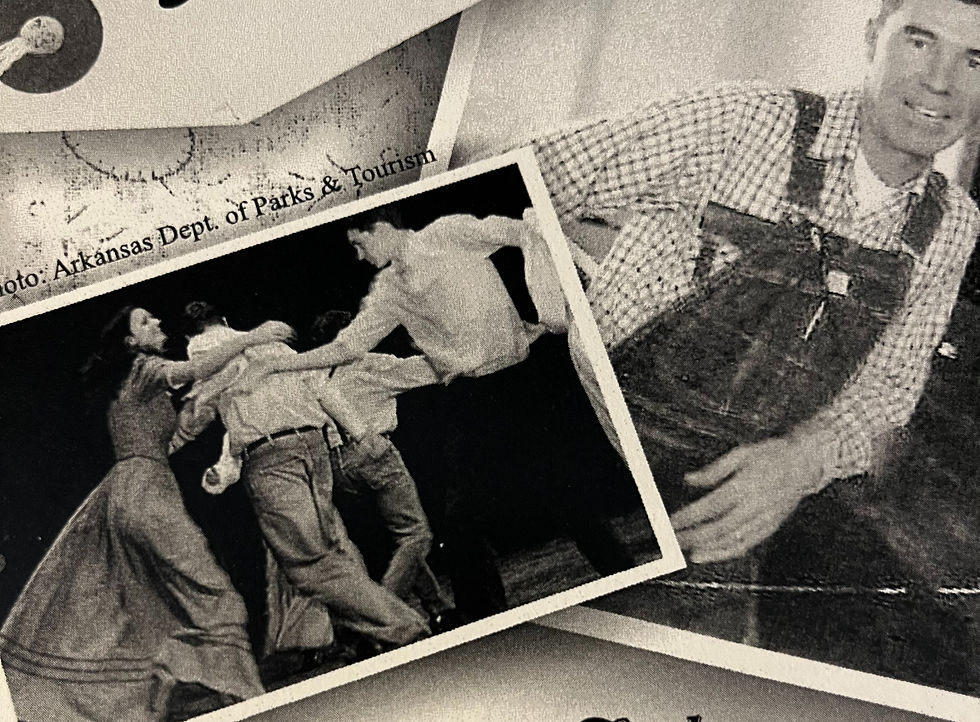
Far left, the author, Elizabeth (Crowell) Taylor, square dances at a music performance at the Ozark Folk Center. Kermit Taylor, well known folk dancer and square dance caller in Stone County for many years, is on the right. Years ago, Kermit taught Dave Smith, father of Austin Smith, middle, how to call square dances. The author is the niece of Dave Smith and cousin of Austin Smith.
Well, dear readers, it took me almost as long to write this second installment as it did for me to cash the checks from my first summer working at the Folk Center. They had a cozy home in a candy box in the bottom left drawer of my dresser, where I kept all important things like my digital camera and the $2 bills I sometimes got in birthday cards from my grandpa. This arrangement seemed perfectly fine until one day when I mentioned in passing that I was being smart and saving up most of my checks. "You're cashing them, right? Just putting the money in your savings account?" asked my mom. I told her that wasn't exactly the case. She interrogated me further, and I decided she was really into splitting hairs about this. Have I mentioned my mom was a teller at a bank? Anyways, she was, and I came to understand that I was committing a crime that wasn't technically punishable by law but seemed to carry the same weight in our family. "Okay, okay! I'll cash them!" I said. I took the checks, the whole box, to the Bank of Mountain View the next day and cashed them all. I can't prove it, but I feel fairly certain an accountant for the state of Arkansas probably experienced a mild cardiac event when they saw all of those consecutive transactions racing down their computer screen.
The rest of that summer and fall, I continued to dance at the Folk Center and dutifully cashed my checks as I received them. I loved dancing, which was usually forbidden by the strict Baptist church we went to. Folk dancing, however, didn't seem to be on the Devil's radar, and that thrilled me. I learned that jig dancing is a form of freedom. There are no choreographed steps like clogging. It's all about each dancer's freedom of expression and individual response to the tune the band plays. So I stomped, shuffled, and scuffled in my high neck tops and long skirts next to old men in overalls little girls in aprons and we all did what felt right.
I stepped on toes and had my toes stepped on as I learned to waltz. The waltz has timing and steps and requires some practice to execute gracefully. Experienced dancers swirled and twirled effortlessly around the stage while the teenagers clunked along audibly whispering and counting steps. It felt frustrating and silly sometimes, as most things do when you are learning, but it made way more sense to me than the uncoordinated swaying I had witnessed as "slow dancing" at school functions. Eventually, we all got better and learned to be ever vigilant so that we didn't bump into other couples spinning around the stage.
And, of course, we square danced. At that time, each music show started with a square dance and reconvened after intermission with another one. Before the show, all dancers got together on the outside stage behind the big auditorium and practiced steps to squares like Grapevine Twist, Three Little Sisters, Birdie in the Cage, or Wave the Ocean. Quite a few of the adults had worked at the Folk Center for the life span of us younger folks and were our guides to this new language. What does it mean to "Wave the ocean, wave the shore, wave this time and wave no more? " Ah. Its a code, a language for just your hands and feet. Grown people like Dave and Maria Smith, Punkin and Floyd Wallace, and Joe and Susan Jewell helped us immensely. They pulled us in the right directions when we tried to do-si-do instead of allemande left. they pushed us on to the next partner when we forgot to go "All around that ring!" and they held us back with a firm grip when we enthusiastically, but in error, started to whirl into the middle of the circle when it wasn't our turn. We learned about folk culture and traditional dancing, but I know now that they also taught us much more than just how to move our feet.
Comments